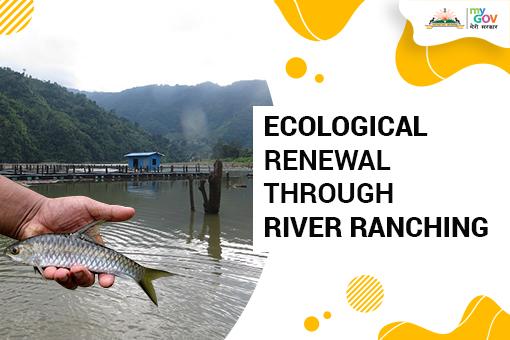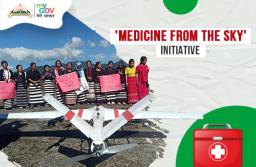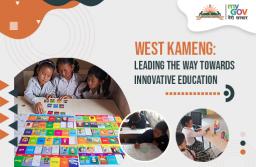In a landmark step toward ecological restoration and sustainable development, the Department of Fisheries, Longding, has launched its first-ever River Ranching Program at the Tewai and Teru Rivers.
In the presence of Hon’ble Minister Shri Gabriel D Wangsu, over 90,000 fingerlings, including species like Rohu, Katla, Mirga, and more, were released into the rivers.
This initiative is designed to:
✅ Revive native fish populations
✅ Enhance biodiversity and protect aquatic ecosystems
✅ Promote sustainable fishing and support local livelihoods
Join the Discussion on MyGov:
Which other rivers in Arunachal Pradesh could benefit from river ranching?
How can traditional ecological knowledge contribute to the success of such initiatives?
Let's work together to restore and preserve our natural resources!













BrahmDevYadav 2 weeks 4 days ago
मछली की आबादी कैसे बढ़ाई जाए?
अच्छी मछली आबादी को बढ़ावा देने के लिए तालाब के कम से कम 25% हिस्से में जलीय वनस्पति बनाए रखने की कोशिश करें। तालाब के मालिक अपने तालाब में कृत्रिम मछली आवास जोड़ना चाह सकते हैं। यह विशेष रूप से उपयोगी हो सकता है जब तालाब में वनस्पति का स्तर कम हो या सफल मछली स्पॉनिंग को बढ़ावा देने के लिए आवास जोड़कर।
BrahmDevYadav 2 weeks 4 days ago
How can we help save the fish?
There are six ways to help save migratory freshwater fish which are as under:-
1. One Keep a closer eye on freshwater fish populations. We need to improve how we track fish
in different areas over a long period.
2 Take care of our rivers.
3 Know where fish need to go.
4 Understand and fix problems.
5 Work together.
6 Get everyone involved.
BrahmDevYadav 2 weeks 4 days ago
How can we increase the population of fish?
Try to maintain aquatic vegetation in at least 25% of a pond to promote good fish populations. Pond owners may wish to add artificial fish habitat to their pond. This can be particularly useful a pond has low levels of vegetation or by adding habitat to promote successful fish spawning.
BrahmDevYadav 2 weeks 4 days ago
How do we restore fish populations?
We focus on four priority habitat restoration approaches, where we can have the biggest impact to fishery production:-
1. Opening rivers.
2. Reconnecting coastal wetlands.
3. Restoring shallow corals.
4. Rebuilding shellfish populations.
BrahmDevYadav 2 weeks 4 days ago
4. Long-term management:
Fish restoration is a long-term process and ongoing monitoring and management are necessary
to ensure the success of restoration efforts.
BrahmDevYadav 2 weeks 4 days ago
3. Other Important Considerations:-
Monitoring fish populations:-
Regular surveys and monitoring of fish populations can help track progress and identify
areas where further action is needed.
Collaboration and partnerships:-
Effective fish restoration often requires collaboration among government agencies,
conservation organizations and local communities.
BrahmDevYadav 2 weeks 4 days ago
2. Invasive Species Control:-
Controlling or eradicating invasive fish species:-
Non-native fish species can compete with native fish for resources, prey on native fish,
and hybridize with them, impacting genetic diversity.
Preventing the introduction of new invasive species:-
Strict regulations on the movement of aquatic organisms and educating the public about the
risks of releasing non-native fish can help prevent new invasions.
BrahmDevYadav 2 weeks 4 days ago
4. Protecting and enhancing spawning grounds and nursery areas:-
Creating or restoring areas with suitable substrate, water flow and vegetation for spawning and rearing young fish is essential for recruitment.
BrahmDevYadav 2 weeks 4 days ago
3. Restoring riparian vegetation:-
Healthy riparian zones provide shade, reduce erosion and offer cover and food sources for
fish.
2. Improving water quality:-
Pollution, sedimentation, and temperature fluctuations can negatively impact fish
populations. Efforts to reduce these stressors are crucial.
BrahmDevYadav 2 weeks 4 days ago
1. Restoring natural river flows:-
Imitating natural flow patterns including high and low flows, is essential for many native fish species, especially those that rely on floods for spawning and nursery habitat.
2. Removing or modifying barriers to fish migration:-
Dams, weirs and other infrastructure can block fish from reaching spawning grounds and other important habitats. Fishways, alterations to dams or removing the structures altogether can restore connectivity.